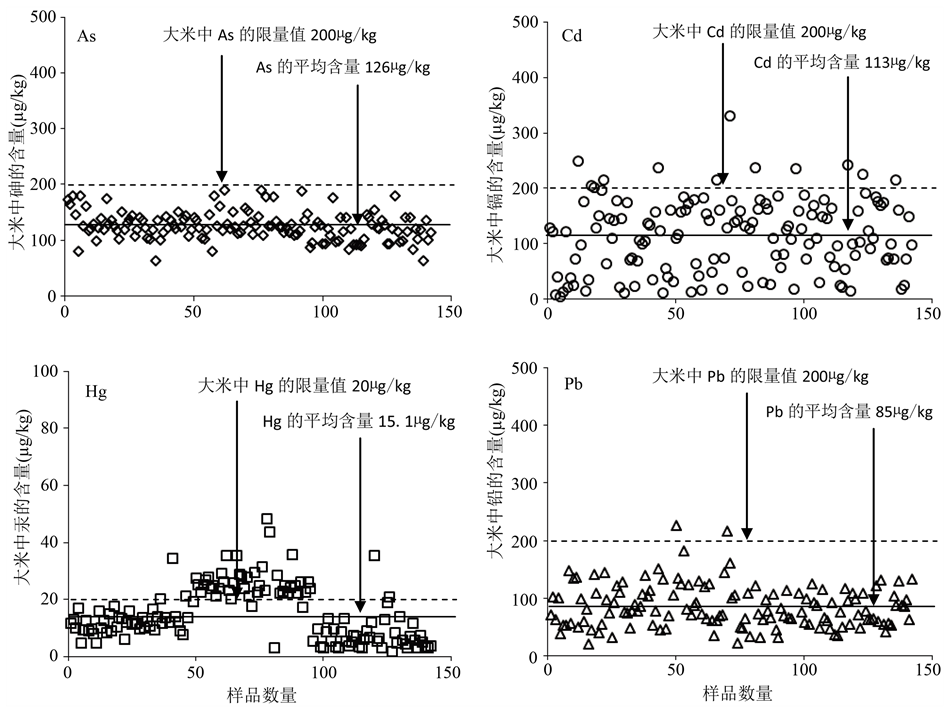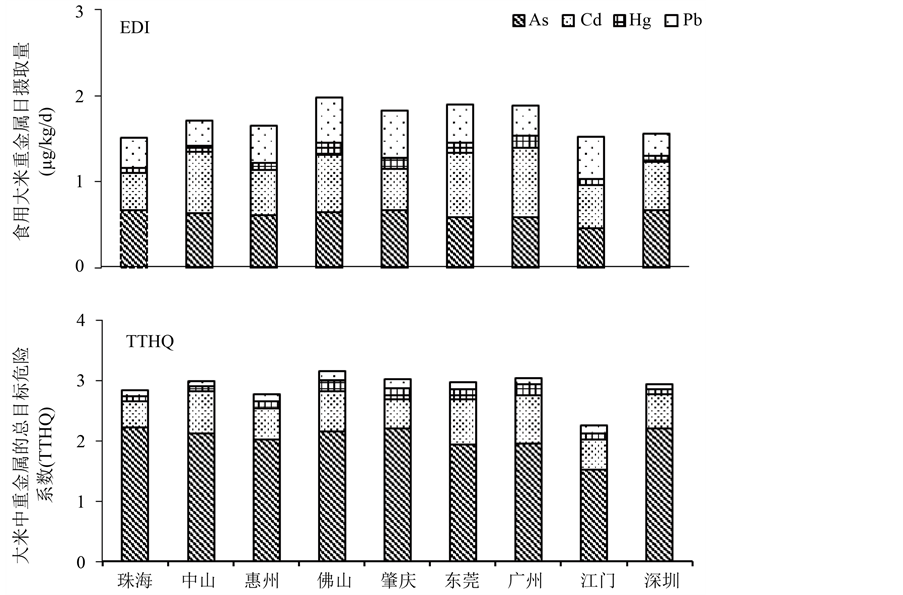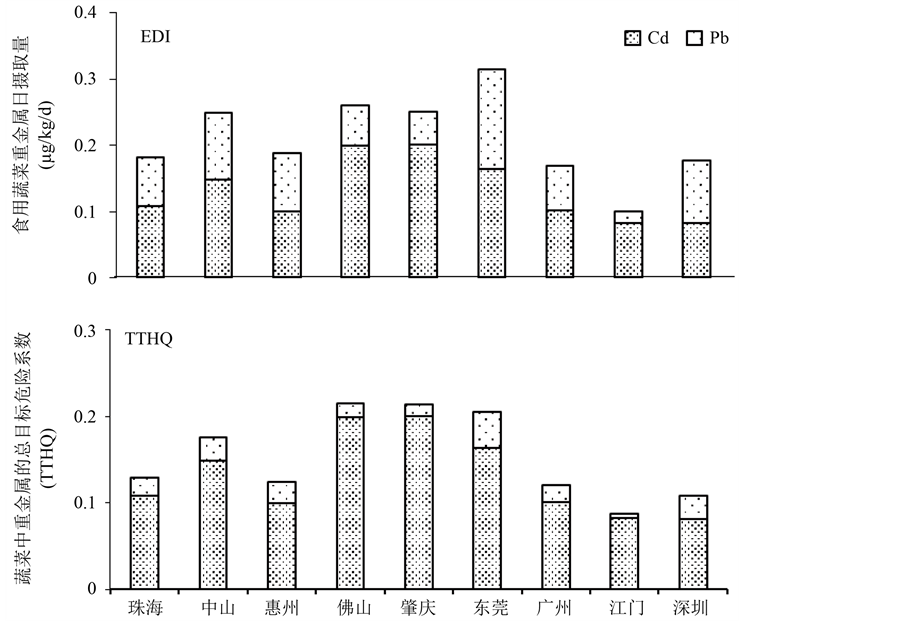1. 引言
我国农田土壤重金属污染严重,2014年国家环保部与国土资源部联合发布的《全国土壤污染状况调查公报》显示,全国耕地土壤污染超标率为19.4%,以无机污染为主,南方污染重于北方,长三角、珠三角污染严重,以镉超标点位最高。严重的农田污染导致农产品品质问题突出,尤其是一些叶菜类农作物(如小白菜、油菜、苋菜等)对重金属镉有极强的富集能力,从而导致膳食摄取成为人群暴露环境重金属的主要途径 [1] [2] [3] ,农产品重金属元素含量与人类健康的关系一直倍受关注。我国大约有65%以上人口以稻米为主食,大米占南方居民食物摄入量中谷类主食的91.2%,同时许多稻米品种具有积累重金属的性状,导致我国南方居民具有较高的重金属摄入量,大米对居民膳食重金属贡献率最高 [2] [4] [5] [6] 。同时,蔬菜作为每日膳食结构中必不可少的组成部分,在居民膳食消费量占用较大比重,其中所含有的重金属主要来源于土壤和水的污染。因此,近年来,随着土壤环境重金属污染的加剧,农产品中重金属含量水平及其暴露风险的评价成为研究热点 [7] 。
环境污染物对人群健康危害的特点是低剂量、长时期和慢性中毒,甚至具有致癌性 [8] ,例如,镉可引起肾脏、骨骼等方面的疾病 [9] ;铅中毒能损害人体神经系统、造血系统、免疫系统等,对儿童心理、智力和行为发育损伤具有不可逆性;汞是一种全球性重金属污染物,主要毒性效应是进入脑组织后,对脑组织和肾脏等造成损害;砷通过呼吸道、消化道和皮肤接触进入人体,在人体的肝、肾、骨骼、肌肉等部位蓄积并产生毒性。砷、铅、汞和镉分别被美国毒物管理委员会列为第1,2,3和7位危及人体健康的有毒物质 [10] 。2013年广东省市场销售大米被报道存在多个批次大米镉含量超标现象,已经引起国家、地方政府和民众的高度重视和广泛关注,特别是人群重金属暴露的途径及其健康影响,倍受关注。尽管此类已有不少相关的研究调查 [11] [12] [13] ,但是珠三角地区人口密集,膳食结构中蔬菜和大米的重金属污染状况与民众的健康风险存在潜在相关性,因此非常必要对大米和蔬菜开展定期地调查监测,以确保市售农产品的食用安全。
本研究于2015年采集了珠江三角洲地区9个城市市售的大米和蔬菜,对所含重金属(砷、镉、汞和铅)含量进行测定分析,并对珠三角地区居民重金属暴露健康风险进行评估,本研究对指导珠三角地区蔬菜的安全生产及保障居民的食品安全有着重要意义。
2. 材料与方法
2.1. 样品的采集
于2015年按照简单随机抽样方法确定样本量,采样范围覆盖珠三角地区9个城市见图1,采样点包括1个中心城区、2个具有代表性的县城区及其下属各1~2个乡镇,每个采样点在市场、超市、商店、专卖店中随机选择2个以上经营单位采集样品,每个城市采集10~30份大米,每份大米样品采购200 g,共采集182份大米样品。在珠三角地区9个城市市区大型超市、农产品批发市场内采集了生菜、菠菜、胡萝卜、土豆、番茄、黄瓜等6个蔬菜品种的302份蔬菜样品,其中62份为有机蔬菜,每个样品采购1000 g。在采购过程中用记录本记录好采购时间、地点和样品大米的品种、产地。
2.2. 样品的检测
大米样品放入全自动样品快速研磨机(JXFSTPRP-96)进行粉碎后,过80目筛,放入自封袋中低温保存。蔬菜样品经去离子水清洗后,再将鲜样放在烘箱中105℃杀青0.5 h,70℃烘干,然后将植株磨碎、混合、待测。经过预处理的大米和蔬菜样品,每份(0.2 g)加入5 mL色谱纯浓硝酸(Merck),用微波消解仪(Anton-Paar PE Multiwave 3000)进行消解。大米样品中汞的测定采用V2O5-H2SO4-HNO3消化法消解。所有玻璃瓶和塑料瓶都先用10%硝酸(优质纯)浸泡12 h,然后用超纯水洗涤.所测结果通过干重-鲜重的换算关系确定蔬菜鲜重的重金属含量。质量控制实验过程通过采用平行双样、标准物质法、加标回收试验,确保检测数据的准确性。分析过程以国家生物成分分析标准物质GBW10010 (GSB-1大米)、GBW10015 (GSB-6菠菜)和GBW10016 (GSB-7茶叶)进行质量控制,As、Cd、Hg和Pb的回收率见表1。
2.3. 健康风险评价方法
采用美国环保署(USEPA)于2000年发布的目标危险系数法(the target hazard quotient, THQ)评价暴露人群的健康风险。如果THQ值 < 1,则表明没有明显的负面影响;反之,则说明对人体健康产生负面影响的可能性很大。计算公式如下:


式中,C为食品中重金属的含量(μg/g);FI为食物摄入率(g/d) (大米日摄入量为291 g/d,蔬菜日摄入量为314 g/d);EF为人群暴露频率(365 d/年);ED为暴露区间(70 a),通常等于人的平均寿命;RfDo为参考剂量(mg/kg/d);BW为人体的平均体重(60 kg);TA为非致癌性暴露的平均时间(365 d/年 × 暴露年数)。目前大部分有毒污染物的人类最大允许摄入量(Reference dose,µg/kg/d)已经建立。WHO于1972年规定的总汞周摄入量(PTWI)为不超过5 μg/kg。USEPA 2007年推荐的As、Cd、Pb的参考剂量分别为0.3、1、3.6 µg/kg/d [14] 。

Figure 1. Study area and sample point setting
图1. 研究区域与样点布设

Table 1. Summary of certified reference element concentrations (µg/kg, mean ± SD, n = 3) in CRMs
表1. 大米和蔬菜标准物质的回收率(µg/kg,平均值 ± 标准差, n = 3)
3. 结果与分析
3.1. 市售大米中重金属含量
从珠江三角洲地区9个城市的超市或市场购买的142份大米样品中As、Cd、Hg和Pb含量的测定结果见图2。从图2中可以看出,大米中总砷含量均值为126 µg/kg;大米镉含量均值为113 µg/kg,中山市(4/16, 25%)、东莞市(3/15, 20%)、惠州市(4/28, 14%)和广州市(2/20, 10%)的大米镉具有较高的超标率,佛山市、肇庆市和江门市市面所售大米镉含量符合国家卫生标准允许值。大米中总汞含量均值为15.1 µg/kg,佛山市和肇庆市的大米全部超标,广州市(17/20)和东莞市(13/15)的大米样品总汞超过国家标准,而珠海市、江门市、中山市和深圳市等市售大米未发现总汞超标现象,总体超标率达36.7%。大米铅含量均值为84 µg/kg,其中有2个大米样品(东莞和惠州各1个)超过国家标准限量值。刘冬英等 [12] 调查了2012年广州市面售大米中铅和镉的污染状况,发现大米中铅含量均值为71.6 µg/kg,超标率为7.5% (15/200),镉含量均值为120.3 µg/kg,超标率为2.5% (5/200)。本研究中广州市大米样品的铅(72.9 µg/kg)和镉(116.9 µg/kg)的含量均值与刘冬英的结果接近,但本次抽检未发现铅超标现象,而镉的超标率较2012年的高。对比周少君等 [9] 对广东省市售大米的2012年调查结果(镉总体超标率为4.5%)和2009年的数据(珠三角,镉超标率为2.8%) [13] ,本次调查珠三角地区2015年市售大米样品中镉超标率有所升高(9.1%)。袁晓博

Figure 2. Heavy metal concentrations (µg/kg) in the market rice
图2. 珠江三角洲地区9个城市市售大米中As、Cd、Hg和Pb含量
等(2011)调查了全国大米中汞含量发现,全国超标率是12%,而江西(35%)、贵州(19%)、江苏(21%)等地区污染程度较为严重 [15] 。本次调查主要反映的是珠三角各地产自南方的市售大米镉含量基本情况,并未反映与大米产地的关系,所以与袁晓博等 [15] 的结果是相一致,这可能与中国南方土壤汞具有较高的背景值有关。可见,珠三角地区市售的产自南方的大米中重金属污染(尤其是镉和汞)的情况不容乐观,需要进一步加强检测和监督力度。
3.2. 蔬菜中重金属含量
从所抽检的240份普通蔬菜和62份有机蔬菜来看(表2和表3),镉在不同蔬菜的含量排序为:菠菜(57.7 µg/kg) > 生菜(33.4 µg/kg) = 土豆(33.2 µg/kg) > 胡萝卜(10.8 µg/kg) > 番茄(7.83 µg/kg) > 青瓜(1.12 µg/kg),而铅在不同蔬菜的含量排序为:菠菜(45.9 µg/kg) > 胡萝卜(15.1 µg/kg) > 生菜(13.7 µg/kg) > 土豆(12.5 µg/kg) > 番茄(9.51 µg/kg) > 青瓜(2.36 µg/kg)。对照食品污染物限量标准(GB 2762-2012),所抽检的全部蔬菜样品中的Pb和Cd均不超标(表2~4)。不同种类的蔬菜对镉和铅元素的吸收能力有显著性差异,叶菜类的吸收能力通常大于瓜果类蔬菜 [16] 。菠菜是6种蔬菜中对镉和铅积累能力最强的蔬菜,瓜果类蔬菜中重金属积累量通常较低。有机蔬菜中镉的含量均比普通蔬菜的稍低一点(除了菠菜中镉),而铅的含量与普通蔬菜的差异不大。佛山市和肇庆市的蔬菜中Cd含量较其他城市高,深圳市蔬菜中镉水平最低。对于铅来说,东莞市蔬菜中铅的含量在所有城市中是最高的,但未超出国家标准。有研究报道,广东省蔬

Table 2. Cadmium and Pb concentrations in ordinary and organic vegetables (µg/kg)
表2. 普通蔬菜和有机蔬菜中Cd、Pb含量比较(µg/kg)

Table 3. Cadmium concentrations in selected vegetables (µg/kg)
表3. 珠江三角洲地区9个城市市售蔬菜中镉含量范围(µg/kg)

Table 4. Lead concentrations in selected vegetables (µg/kg)
表4. 珠江三角洲地区9个城市市售蔬菜中铅含量范围(µg/kg)
菜中重金属污染以铅和镉为主 [17] ,如惠州市的蔬菜中主要污染元素是镉(超标率为15.8%),其他元素未见超标现象 [18] 。蔬菜对土壤重金属的吸收能力,与土壤本身的重金属赋存状态、土壤理化性质、蔬菜品种等 [19] 。由此可见,随着近年来对重金属污染土壤的治理力度不断加大,以及低积累蔬菜品种的筛选,农产品的安全生产可以逐渐得到实现。
3.3. 居民经膳食途径摄入重金属的健康风险评价
通过食用大米和蔬菜,珠三角地区居民所摄入的重金属总量和食用风险系数见图3和图4。由图可知,仅通过食用大米,居民As、Cd、Hg、Pb平均最高摄入量分别为0.67 (珠海)、0.81 (广州)、0.14 (佛山)、0.53 (佛山) µg/kg/d,食用蔬菜的Cd、Pb平均最高摄入量分别为0.20 (佛山)和0.15 (东莞) µg/kg/d。世界卫生组织(WHO)和联合国粮食与农业组织(FAO)推荐As、Cd、Hg和Pb的日摄入量分别为3.0 (无机砷)、0.83、0.57 (无机汞)和10.4 µg/kg/d [21] 。广州市居民具有最高Cd日摄入量(大米 + 蔬菜)已超过FAO/WHO推荐的参考标准,As、Hg、Pb的摄入量则小于参考标准。
对单一重金属的THQ而言,大米中不同重金属的THQ排序为:As > Cd > Hg > Pb,As的THQ高于1,Cd、Hg和Pb的THQ均小于1;蔬菜中Cd和Pb的THQ均小于1 (见图4)。从单一重金属风险来看,大米中As的THQ大于2,显示对居民存在一定的健康风险,从多种重金属复合风险来看,食用大米中重金属的TTHQ都已经远高于1 (见图4),说明珠三角地区居民食用大米存在相当高的健康风险,Zhuang等 [2] 研究证实了大米是居民暴露重金属的最大风险源 [2] 。从单一重金属风险来看,6种珠三角地区蔬菜对居民不存在健康风险,而以往的诸多研究则认为广东省的居民均存在因食用蔬菜导致的Cd和Pb的潜在健康风险 [12] 。从2种重金属复合风险来看,6种市售蔬菜对居民不存在健康风险。

Figure 3. The EDIs and total metal THQ via consumption of rice for local inhabitants in Pearl Delta River area
图3. 珠三角地区居民大米重金属的日摄取量(EDI)和总目标危险系数(TTHQ)

Figure 4. The EDIs and total metal THQ via consumption of vegetables for local inhabitants in Pearl Delta River area
图4. 珠三角地区居民蔬菜重金属的日摄取量(EDI)和总目标危险系数(TTHQ)
由于THQ是以重金属的摄入量等于重金属的吸收量为基础的,但实际上重金属经过人体的消化系统,部分被排出体外,而且摄入的重金属在体内的生物有效性一般低于总量 [20] ,因此仅有部分重金属累积在人体的各个器官。同时,WHO/FAO推荐砷评价的形态是无机砷 [21] ,本研究中测定的是总砷一定程度上高估了砷的风险,有研究表明大米中无机砷大概占总砷的一半。另一方面,本研究中重金属对人体健康风险评价只考虑了居民通过食用大米和蔬菜途径摄入的重金属,没有考虑其他暴露途径,例如通过摄入其他类别食物、饮用水以及吸烟等途径,实际生活存在多元化的重金属暴露风险的可能性。重金属随食品进入人体后能够发生累积,引起慢性损伤,不易察觉,因此即便食品中的重金属符合规定的卫生标准,长期暴露也可能存在风险。通过膳食途径摄入的重金属暴露风险还与消费者的消费习惯、食物烹饪方式和储存方式等密切相关, 因而需要探索更加合理的暴露评价方法,来评估消费人群接触重金属的暴露剂量。
4. 结论
本次对珠三角地区市售农产品中重金属的含量进行了调查测定,并进行了健康风险评价,该评价结果对珠三角地区民众科学认识食品安全问题具有重要的参考意义。研究结果表明珠三角地区居民食用大米而摄入重金属的THQ均大于1,显示膳食摄入所调查的珠三角市售大米存在一定的健康风险,蔬菜中铅、镉的含量及人群摄入量总体处于安全水平。在日常饮食结构中,大米和叶菜类蔬菜所占的比重越大,重金属摄入的含量越高,存在的健康风险则越大。鉴于珠三角9个城市所销售大米中重金属污染的情况不容乐观,有必要进一步加强跟踪检测和监督力度。
基金项目
国家自然科学基金 (No.41301571)。
*通讯作者。